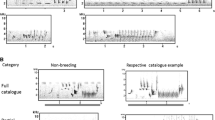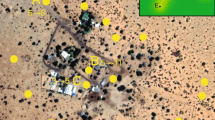Summary
Most temperate zone passerines defend territories during the breeding season. Commonly the size of these territories is estimated by plotting the singing locations of the males. However, an individual's activities need not be restricted to the area used for singing. So far, only little quantitative information has been available to determine how the singing territory relates to the activity range of male songbirds. Here, we present a study in which we used radio-tracking techniques to collect quantitative data on the spatial behaviour of 11 male territorial Nightingales (Luscinia megarhynchos). The results show that the singing territories made up only about 50% of the activity ranges. Nevertheless, males spent over 90% of the time within the singing territory. Singing territories almost never overlapped but activity ranges overlapped in all cases with the activity range of at least one neighbour. Males intruded into neighbouring territories throughout the season but the longest excursions were made before and during the female fertile period. The time spent for forays correlated significantly with song rate and territories of males with higher song rates in turn were less frequently the object of forays by other males. Song rate can be indicative of male quality, so that our findings strongly suggest that foray behaviour is related to male quality in nightingales.
Zusammenfassung
Männliche Singvögel markieren mit ihrem Gesang ein Revier. Empirische Studien zeigen allerdings, dass Männchen und Weibchen das Revier verlassen und in Reviere von Nachbarn eindringen. Solche Ausflüge sind vor allem in dichteren Habitaten schwierig zu beobachten, so dass für die meisten Vogelarten kaum Datenmaterial für die Raumnutzung außerhalb der Gesangsreviere vorliegt. In dieser Studie haben wir über den Verlauf der Brutsaison 11 männliche territoriale Nachtigallen telemetriert. Die Ergebnisse zeigen, dass die Aktionstradien im Mittel doppelt so groß waren, wie die Gesangsreviere und dass die Männchen ca. 8% der Zeit außerhalb der Gesangsreviere verbracht haben. Dabei überlappten die Aktionsräume benachbarter Männchen deutlich. Die Männchen drangen vor allem vor und während der fertilen Phasen der Weibchen in Nachbarreviere vor. Darüber hinaus drangen Männchen mit höherer Gesangsaktivität signifikant länger in Nachbarreviere ein, als Männchen mit geringerer Gesangsaktivität. Reviere von Männchen mit höherer Gesangsaktivität wurden dabei auch signifikant seltener von anderen Männchen besucht. Da die Gesangsaktivität mit der Qualität eines Männchens zusammenhängen kann, weisen die Ergebnisse darauf hin, dass qualitativ bessere Männchen mehr in Nachbarreviere eindringen als qualitativ schlechtere Männchen und die Reviere der qualitativ besseren Männchen auch weniger häufig von Rivalen besucht werden. Dass solche Ausflüge von Männchen für Versuche zu außerpaarlichen Kopulationen genutzt werden, ist anzunehmen, muss aber noch geklärt werden. Die räumlichen Beziehungen territorialer Männchen reflektieren darüber hinaus vermutlich Aspekte der sozialen Beziehungen.
Similar content being viewed by others
References
Amrhein, V. (1999): Das Revierverhalten der Nachtigall Luscinia megarhynchos: Fingerzeige auf sexuell selektierte Muster. Diplom, Universität Basel, Switzerland.
Bensch, S. & Hasselquist, D. (1992): Evidence for female choice in a polygynous warbler. Anim. Behav. 44: 301–311.
Catchpole, C. & Slater, P.J.B. (1995): Bird song: biological themes and variations. Cambridge UK.
Chandler, C. R., Ketterson, E. D. & Nolan, V. (1997): Effects of testosterone on use of space by male dark-eyed juncos when their mates are fertile. Anim. Behav. 54: 543–549.
Chandler, C. R., Ketterson, E. D., Nolan, V. & Ziegenfus, C. (1994): Effects of testosterone on spatial activity in free-ranging male dark-eyed juncos,Junco hyemalis. Anim. Behav. 47: 1445–1455.
Glutz von Blotzheim, U.N. (1988): Nachtigall. In: Glutz von Blotzheim, U. N. (Ed.): Handbuch der Vögel Mitteleuropas, Band 11/I: 137–194. Wiesbaden.
Grüll, A. (1981): Untersuchungen über das Revier der Nachtigall (Luscinia megarhynchos). J. Ornithol. 122: 259–285.
Hanski, I. K. (1992): Territorial behaviour and mixed reproductive strategy in the Chaffinch. Ornis Scand. 23: 475–482.
Hanski, I. K. & Haila, Y. (1988): Singing territories and home ranges of breeding Chaffinches: visual observation vs. radiotracking. Orn. Fenn. 65: 97–103.
Hasselquist, D., Bensch, S. & von Schantz, T. (1996): Correlation between male song repertoire, extrapair paternity and offspring survival in the great reed warbler. Nature 381: 229–232.
Hultsch, H. & Todt, D. (1982): Temporal performance roles during vocal interactions in nightingales (Luscinia megarhynchos). Behav. Ecol. Sociobiol. 11: 253–260.
Johnsen, A. & Lifjeld, J. T. (1995): Unattractive Males Guard Their Mates More Closely — an Experiment with Bluethroats (Aves, Turdidae,Luscinia-S-Svecica). Ethology 101: 200–212.
Kenward, R. (1987): Wildlife radio tagging. London.
Krebs, J. R., Aschroft, R. & Webber, M. (1978): Song repertoires and territory defence in the great titParus major L. Nature 271: 539–542.
Maciejok, J., Saur, B. & Bergmann, H. H. (1995): Was tun Buchfinken (Fringilla coelebs) zur Brutzeit außerhalb ihrer Reviere. J. Ornithol. 136: 37–45.
Møller, A. P. (1991): Parasite load reduces song output in a passerine bird. Anim. Behav. 41.
Naef-Daenzer, B. (1994): Radiotracking of great and blue tits: new tools to assess territoriality, home-range and resource distribution. Ardea 82: 335–347.
Naguib, M. (1999): Effects of song overlapping and alternating on nocturnally singing nightingales. Anim. Behav. 58: 1061–1067.
Neudorf, D. L., Stutchbury, B. J. M. & Piper, W. H. (1997): Covert extraterritorial behaviour of female hooded warblers. Behav. Ecol. 8: 595–600.
Nowicki, S., Searcy, W. A. & Hughes, M. (1998): The territory defence function of song in song sparrows: A test with the speaker occupation design. Behaviour 135: 615–628.
Pitcher, T. E. & Stutchbury, B. J. M. (2000): Extraterritorial forays and male parental care in hooded warblers. Anim. Behav. 59: 1261–1269.
Radesäter, T., Jakobsson, S., Andbjer, N., Bylin, A. & Nyström, K. (1987): Song rate and pair formation in the willow warbler,Phylloscopus trochilus. Anim. Behav. 35: 1645–1651.
Rätti, O. & Siikamki, P. (1993): Female attraction behaviour of radio tagged polyterritorial pied flycatcher males. Behaviour 127: 279–288.
Saino, N., Galeotti, P., Sacchi, R. & Møller, A. P. (1997): Song and immunological condition in male barn swallows (Hirundo rustica). Behav. Ecol. 8: 364–371.
Schulze-Hagen, K., Leisler, B., Schäfer, H. M. & Schmidt, V. (1999): The breeding system of the aquatic warblerAcrocephalus paludicola — a review of new results. Vogelwelt 120: 87–96.
Smiseth, P. T. & Amundsen, T. (1995): Female bluethroats (Luscinia s. svecica) regularly visit territories of extrapair males before egg laying. Auk 112: 1049–1053.
Stutchbury, B. J. M. (1998): Extra-pair mating effort of male hooded warblers,Wilsonia citrina. Anim. Behav. 55: 553–561.
Todt, D. & Naguib, M. (2000): Vocal interactions in birds: The use of song as a model in communication. Advan. Study Behav. 29: 247–296.
Author information
Authors and Affiliations
Corresponding author
Rights and permissions
About this article
Cite this article
Naguib, M., Altenkamp, R. & Griessmann, B. Nightingales in space: song and extra-territorial forays of radio tagged song birds. J Ornithol 142, 306–312 (2001). https://doi.org/10.1007/BF01651369
Accepted:
Published:
Issue Date:
DOI: https://doi.org/10.1007/BF01651369




